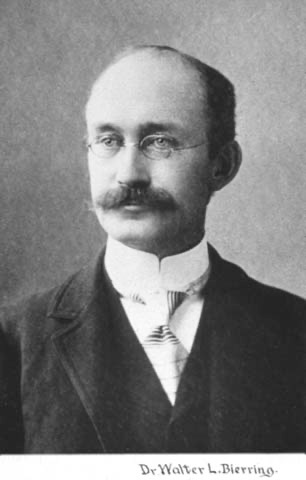Main navigation
Researched and Written by
Dr. Fred Stamler

Dr. Walter L. Bierring, having just been awarded his medical degree, departed for Europe on March 22, 1892, and arrived back in Iowa City in September of 1893. In somewhat less than 17 months he had managed to gain exposure to many of the leaders in Bacteriology and Pathology in Vienna, Heidelberg, Berlin, and Paris, although he was disappointed in not being able to study with Pasteur or Koch, both in the late stages of their careers. In an historical account of the department, published in the Iowa State Medical Society Journal in 1937, he recalled with enthusiasm and considerable detail the gratifying experiences of this scientific quest.
Upon Dr. Bierring’s return to the University he was met at the Rock Island station by two medical students with applications for positions as laboratory assistants. When informed that the total budget for assistants was $100, they immediately agreed to share that sum, and an understanding was reached on the spot. The students were William R. Whiteis and Lee Wallace Dean. For the next three very busy years, this trio constituted the entire staff of the new Department. Whiteis and Dean received their MD degrees in due course and went on to positions of eminence in other fields of medicine. Dr. Whiteis ultimately became Professor of Obstetrics and Dr. Dean became Professor and Head of Otolaryngology as well as Dean of the Medical School and Director of University Hospital before leaving Iowa City to practice medicine in St. Louis as Head of Otolaryngology at Washington University.
Dr. Bierring, in writing of the early years of the Department, characterized his position as truly "full time". In addition to courses of didactic instruction, laboratories of Microscopic Pathology and Bacteriology were quickly organized and put into operation, aided by use of tissue specimens, blocks and bacterial cultures obtained from medical centers of Europe and the eastern United States. In the spring of 1894 Dr. Bierring was able to return to Europe to attend a course in Bacteriology at the Pasteur Institute in Paris, where his principal mentors were Rous, Metchnikoff, and Borrel. A highlight of his stay was an extended audience with Louis Pasteur, then in semiretirement, but still keenly aware of advances in Bacteriology throughout the medical world. As a result of his summertime studies, Dr. Bierring was able to undertake the production of diphtheria antitoxin upon his return to Iowa City in the fall of 1894. L.W. Dean (MD, 1896) was his principal associate in this work, and the work provided the material for Dean’s Master of Science thesis. The antitoxin produced in 1895 was the first produced in this country outside of New York City.
In all, some 300 doses of antitoxin for therapeutic or immunizing use were administered clinically without any untoward effects. In the meantime, interest in Bacteriology had become so great locally that a special one month course known as the Pasteur Course of Bacteriology was approved and first offered at the close of the school year in 1895. It was open to physicians and students and was continued yearly through 1900, after which it was replaced by courses incorporated into the regular curriculum. The Department expanded in scope in yet another direction, when the teaching of Histology and Embryology was added to the Departmental functions. The senior assistant, Dr. Whiteis, was accordingly given the title of Professor of Histology and Embryology in 1896.
Dr. Bierring made a third European trip in the spring of 1896, with visits to medical centers in Rome, Florence, Zurich, Munich, and Heidelberg, and longer stays in Vienna and Paris. His stay in Paris was saddened by the recent death of Louis Pasteur. Everywhere he went, he learned of progress in Bacteriology, and he returned to Iowa City with renewed enthusiasm for teaching and conducting studies in Applied Bacteriology. These studies included work on bacterial diseases of the eye, bacteriology of water, and the role of bacteria in the arts of sciences. In collaboration with Professor Rockwood, results of extensive investigations of the use of formaldehyde as a disinfectant were published in the Journal of The Iowa State Medical Society in 1898.
In 1894 the Medical College program was extended to four yearly sessions of six months each. Student courses in Pathology and Bacteriology included lectures and laboratory exercises extending through the sophomore, junior and senior years. These included the preparation of bacterial cultures and histologic slides of tumors, diseased organs and tissues, as well as the study of gross and microscopic materials. Instruction and practice in autopsy technique was included. Practical work was correlated with didactic lectures of the conditions studied in the laboratory. By 1900, seven courses were listed in the Catalogue, although the departmental faculty listed only Professor Bierring with John T. McClintock, MD, and Theodore W. Kemmerer, MD as demonstrators. Dr. McClintock’s name had first appeared in the departmental roster several years before, as a medical student. Several years later he transferred to Physiology and later headed the Department for many years, also serving as Associate Dean for several years. In later years Dr. McClintock was a major contributor to the history "One Hundred Years of Iowa Medicine" published by the State Medical Society in 1950.